How to pick the best air purifiers in 2021, according to experts
How do air purifiers work?
Air purifiers are designed to remove indoor air pollution which can be made up of small particles in the air. Indoor air pollution primarily comes from cooking, automobile emissions, dust and fires, and can irritate the lungs or trigger allergic reactions, explained Kenneth Mendez, president of the nonprofit Asthma and Allergy Foundation of America. And according to the Environmental Protection Agency, the air inside our homes can be more polluted than the air outside.
“We take about 20,000 breaths each day and spend 90 percent of our time indoors,” Mendez noted. And if you’re continuing to work from home, reducing exposure to particles that can trigger things like allergies and asthma symptoms is important. « If you live in an area with high outdoor pollution, like a metropolitan city, it’s essential to monitor the air quality in your home, » he added.
How to find the best air purifier for you
Before buying an air purifier, narrow down your specific needs, advised Nidhy Varghese, MD, a pediatric pulmonologist in Texas. For example, maybe you’re looking for a purifier for allergies or to protect you against gases. Or maybe you cook frequently and want a purifier to filter out particles produced from your oven and stove.
Varghese recommends seeking a purifier with a HEPA filter for the best results. She said it’s also worthwhile to consider a filter that’s been independently rated by the Association of Home Appliance Manufacturers (AHAM), she said. All air cleaners certified by the AHAM and given a clean air delivery rating, or CADR, have been tested in an independent laboratory and across the same metrics.
“We put all products on a level playing field regardless of technology, so consumers can easily compare between products,” said Jill Notini, vice president of communications and marketing for AHAM. “We test for things like tobacco smoke, dust and pollen.”
The higher the CADR rating, the more effective and faster the air cleaner is at filtering the air. Notini advises shoppers to pay attention to the rating when shopping. Davidson also encourages shoppers to pay attention to how often the air purifier will require a replacement air filter and how many square feet the air purifier can clean.
Some air cleaners use electrostatic charges and generate a small amount of ozone as a byproduct, said Mendez. Ozone is very reactive and is effective for removing odors and killing mold. But it can also « can cause health problems at high concentrations, » according to the EPA, which notes that ozone generators are often billed as air cleaners. Selecting an independently-rated air purifier will ensure your air cleaner produces less than the EPA-designated ozone limit of 0.08 parts per million. “By using an independent agency like ours, you can make sure you’re getting the right product,” said Notini.
Top-rated air purifiers in 2021
With expert guidance and reader favorite brands in mind, we rounded up air purifiers from Blueair, Dyson and more, specifically taking into consideration their cleaning capacities, AHAM approval and HEPA filtration.
Air purifiers with HEPA filters
Instant Large Air Purifier
The Instant Air Purifier comes in two sizes: Small — which has a cleaning capacity of 126 square feet — and Large — which has a cleaning capacity of 388 square feet. Both models feature a 3-in-1 filtration system, including a HEPA-13 filter and a carbon filter, as well as an antimicrobial coating on filters to prevent bacterial growth. Notably, the brand claims it can remove 99.9 percent of the virus that causes Covid from treated air. Air purifiers are available in Charcoal and Pearl colors, and they also feature sensors that monitor air quality and a day-to-night mode.
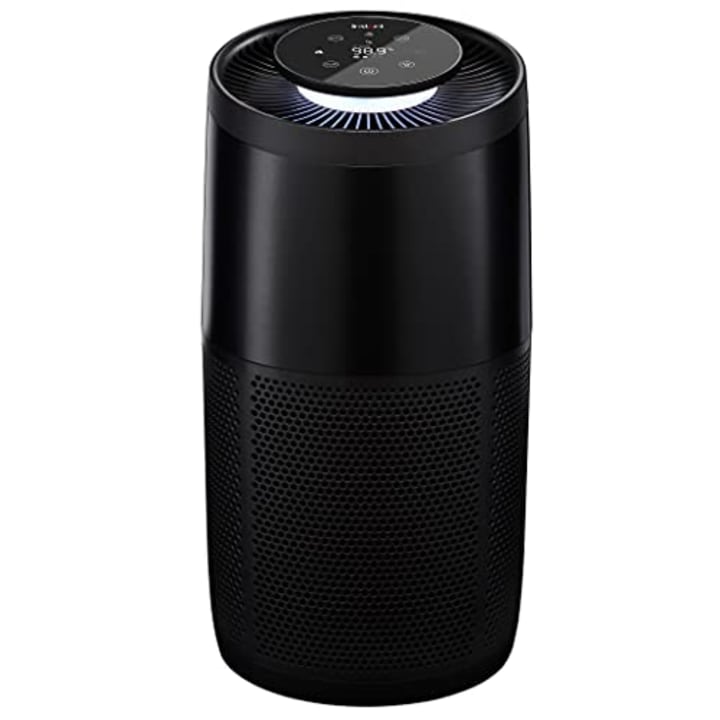
Dyson Purifier Cool
One of Dyson’s newest air purifiers, the Dyson Purifier Cool is designed to clean air more efficiently than previous models and do it more quietly. Its re-engineered filtration system makes the entire machine meet the HEPA H13 standard, not just the filter — the air purifier can capture 99.97 percent of particles that are as small as 0.3 microns. The air purifier allows you to choose from multiple modes, and it has sensors that analyze the air for pollutants. It’s Wi-Fi equipped, so you can control it from Dyson’s app or via Amazon Alexa, Siri and Google Home. The air purifier is available in Nickel/Black and White/Silver.

PARTU HEPA Air Purifier
This air purifier is an affordable option that’s ideal for spaces like at-home offices. It boasts a three-stage filtration system including a pre-filter, a HEPA filter and an activated carbon filter. It also offers a nightlight in seven color options and three fan speed settings. The air purifier has a cleaning capacity of 160 square feet.
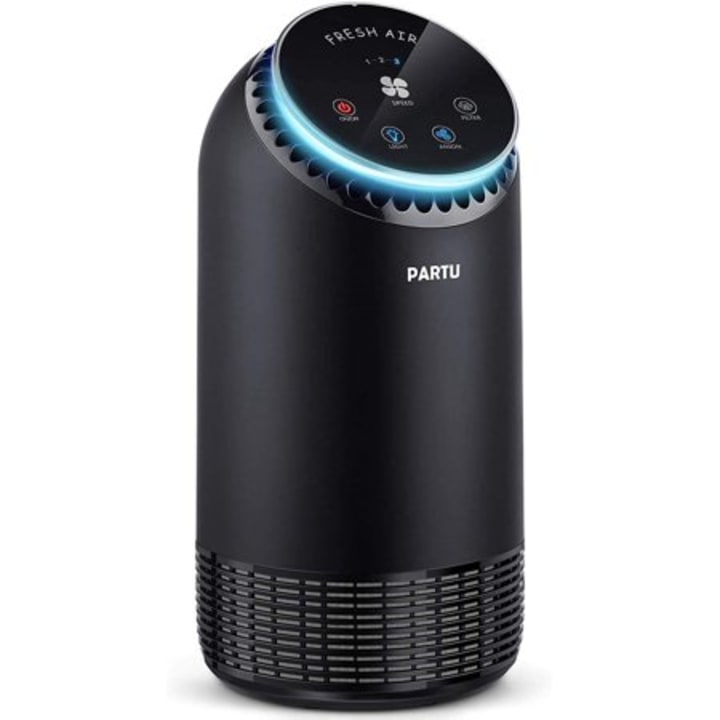
Cuisinart Purxium Freestanding Air Purifier
In addition to its HEPA filter, Cusinart’s air purifier also features washable, reusable metal filters and active carbon filters, all of which work together to capture 99.9 percent of airborne particles 0.1 microns or larger. It offers a timer, an automatic shutoff option and four fan speeds. The air purifier comes in two sizes: Freestanding, which has a cleaning capacity of 1,000 square feet, and Countertop, which has a cleaning capacity of 500 square feet.
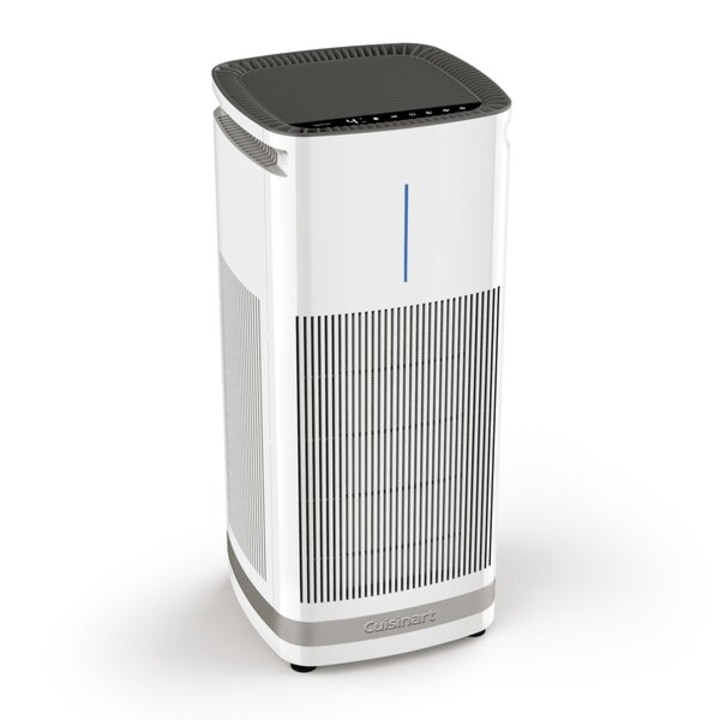
Mila Air Purifier
The Mila Air Purifier allows you to adjust its fan speed to your desired air quality, and through its companion app, you can see how long it will take for the air purifier to achieve it. You can also view information like the humidity level and the air quality inside and outside your home through the app. The air purifier has a built-in carbon monoxide sensor, too. While it comes with the brand’s basic filter, you can choose from a variety of specialized HEPA filters designed for homes with pets, kids, allergy sufferers and more. Additionally, the air purifier detects room presence, making it quieter when you’re in the room and louder — to offer a deeper clean — when you leave. It has a cleaning capacity of 1,000 square feet.
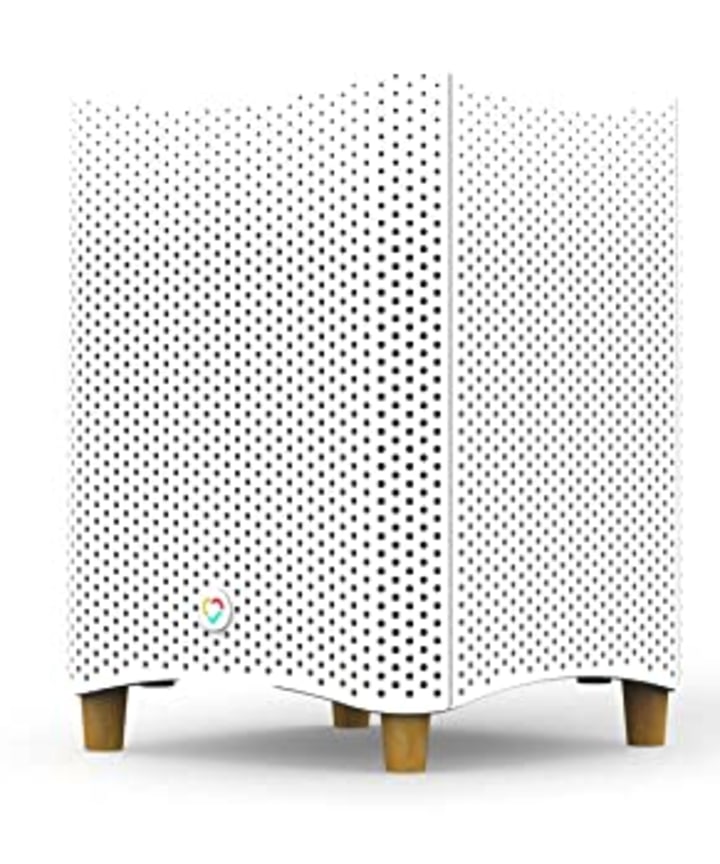
Bissell air320 Max Smart WiFi Air Purifier
Bissell’s air purifier is Wi-Fi equipped, allowing you to control it through the brand’s app or monitor air quality when you’re not home. Its three-stage filtration system includes a pre-filter, an activated carbon filter and a HEPA filter. The air purifier bosses an Automated CirQulate System that monitors and provides indoor air quality readings, and it adjusts to the appropriate fan speed accordingly. The air purifier has a cleaning capacity of 308 square feet.

Levoit LV-H132 Air Purifier
The Levoit LV-H132 removes particles from the air with its three-stage filtration system that includes a pre-filter, a true HEPA filter and an activated carbon filter. It circulates the air in the room over four times in an hour and is equipped with a built-in smart filter replacement reminder and night light. It has a cleaning capacity of 129 square feet.
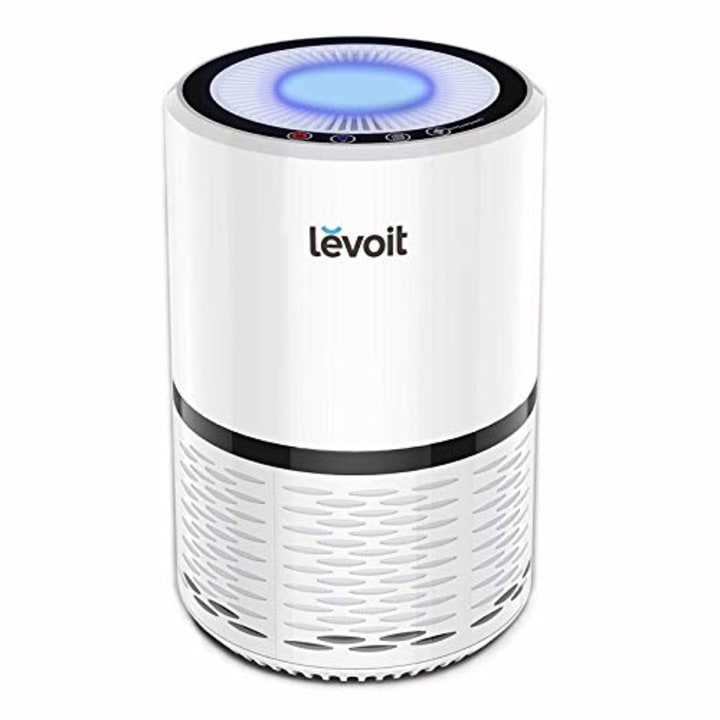
GermGuardian AC4825 Air Purifier
The GermGuardian AC4825 is a 3-in-1 air purifier that includes a HEPA filter, charcoal and PCO filter, UV-C sanitizer and TIO2 treatment. It is equipped with three speed settings and comes with a filter replacement indicator. It is AHAM-approved and has a cleaning capacity of 167 square feet.

Honeywell True HEPA Air Purifier
This model is made for larger rooms and has a true HEPA filter. Honeywell claims this purifier filters and circulates air up to five times an hour. It is relatively affordable given its size and comes with features like a timer setting and filter change indicator. It has two filters: a pre-filter to capture large particles like pet hair and lint, and a HEPA filter for smaller particles. It is AHAM-approved and has a cleaning capacity of 465 square feet.

Austin Air Healthmate Standard Air Purifier
This model uniquely has four filters, removing a different type of particle at each one. This includes a large particle pre-filter for dust and dander, a medium pre-filter for mold, a carbon filter for chemicals and gases and a HEPA filter with a 60-square-foot radius for smaller particles. This model is much larger and heavier than others — it weighs about 47 pounds — but includes rollers for easier transportation. It has a cleaning capacity of 1,500 square feet.

Other notable air purifiers to consider
Molekule Air Purifier Pro
Molekule’s Air Purifier Pro cleans air via the brand’s patented filter technology: photo electrochemical oxidation (PECO). The brand claims this air purifier offers triple the airflow of its other models and that its particle sensing tech is three times as precise as previous models, giving you more accurate air quality information. You can utilize the product’s auto-protecting quiet mode at night, and control the air purifier using the Molekule app. It’s also built with a natural leather strap so you can move it around your home. This air purifier has a cleaning capacity of 1,000 square feet.
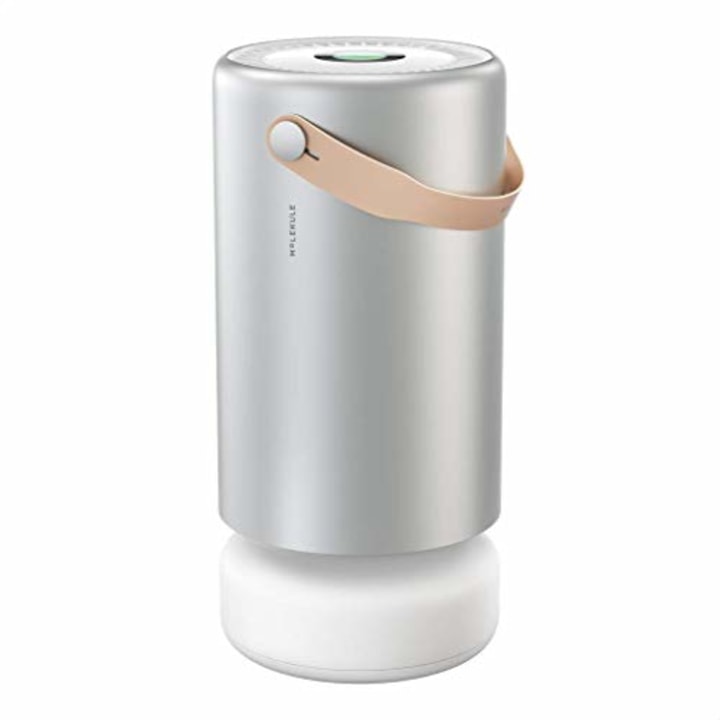
Blueair Pure 411 Auto
The Blueair Pure 411 Auto comes with the brand’s HEPASilent technology (which is not the same as an approved, true HEPA filter). In auto mode, the air purifier adjusts fan speed based on real-time air quality conditions it monitors through an integrated sensor. It features a three-stage filtration system and you can customize the color of your air purifier by purchasing fabric pre-filters, available in five colors. It’s AHAM-approved and has a cleaning capacity of 190 square feet.
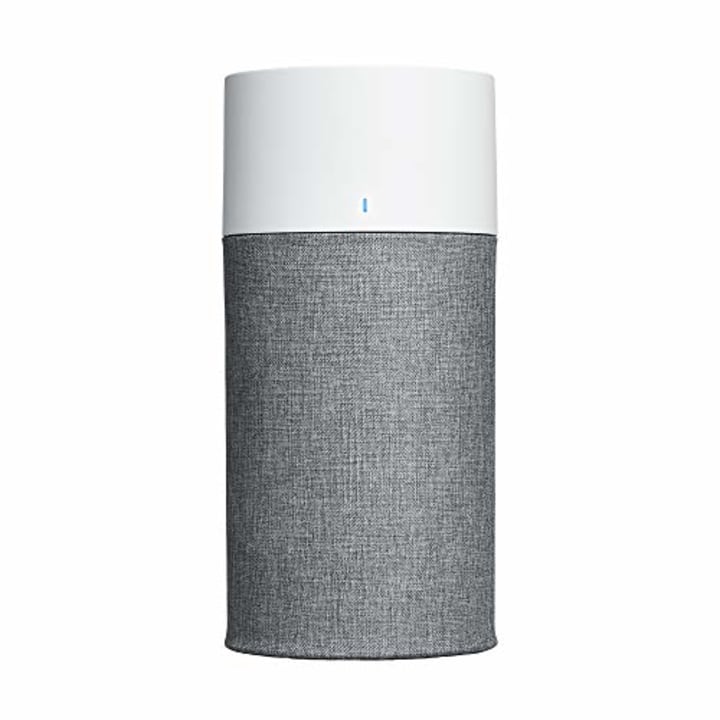
Do air purifiers prevent coronavirus? No.
Air purifiers do not prevent the spread of coronavirus, but the CDC states that portable HEPA filtration units specifically “are effective at cleaning air within spaces to reduce the concentration of airborne particulates, including SARS-CoV-2 viral particles.” Formerly, the World Health Organization (WHO) and other groups were resistant to acknowledge the spread of Covid through the air. But such groups now agree that airborne transmission is one of the main ways Covid spreads, which the CDC describes as “breathing in air when close to an infected person who is exhaling small droplets and particles that contain the virus.”
Previously, Varghese explained that simply filtering airborne particles wouldn’t help stop the spread of the virus, given the small size of coronavirus particles — according to the CDC, the particle size of Covid is around 0.1 micrometers, which is less than the 0.3 micron limit for HEPA filters, Varghese added. However, the CDC notes that “the virus generally does not travel through the air by itself,” and is often trapped in larger droplets like respiratory droplets and other exhaled particles, which are less than 5 microns in size. Thus, “HEPA filters are no less than 99.97 percent efficient at capturing human-generated viral particles associated with SARS-CoV-2,” according to the CDC.
The difference between air purifiers, air cleaners and air filters
Air purifiers are often conflated with air filters, but they differ slightly, said John McKeon, MD and CEO of Allergy Standards — an organization that certifies products as “asthmas and allergy friendly,” among other things.
- Air filters trap and collect dirt and debris in a filter, and are commonly found in heating and ventilation systems. They can significantly reduce the amount of pollutants, allergens and dust in your home.
- Air cleaners remove more particulate from the air than the average filter, said McKeon. The device consists of a fan to draw air in and a filter to remove particulate from that air. While air cleaners often include filters, they are overall more robust in cleaning the air than air filters. Regardless, most companies will use the terms air cleaner and air purifier interchangeably.
- Air purifiers use a process to “deactivate” airborne toxins like pathogens, McKeon explained. Some purifiers use ultraviolet light sterilization to kill mold and bacteria while others use an electrostatic filter to draw particles to metal plates. Most air purifiers rely on a combination to trap as many particles, gases and bacteria as possible.
What is a HEPA filter?
You’ve likely seen this designation on air purifiers and other products before. HEPA stands for “high efficiency particulate air.” HEPA filters are physical filters designed to clear out at least 99.7 percent of particulates that are 0.3 microns or larger in size. For reference, a micron, or micrometer, is about one twenty-five thousandth of an inch and designated with an μm.
Any air cleaner that has a HEPA filter has been tested and approved by the nonprofit Institute of Environmental Sciences and Technology. This means they are true HEPA. Some filters will label themselves as “HEPA-type” or “HEPA-like,” but these filters are not verified HEPA so they may not be as effective. True HEPA filters draw particles in via a fan and trap them in a web of fibers. They perform better than standard filters and have become increasingly popular, Varghese said.
Molekule and its PECO filter
Molekule’s air filters are different from HEPA filters. Regular HEPA air purifiers target airborne particles in the air. Molekule’s filter uses its own patented filter technology: photo electrochemical oxidation (PECO). According to Molekule, PECO uses free radicals, or highly reactive atoms, to break down pollutants at the molecular level. PECO filters remove — or deactivate, rather than filter out — common gases, bacteria, viruses and mold in the air, according to the brand.
Molekule worked with researchers at the Lawrence Berkeley National Laboratory (LBNL) to test its new filter technology, which it claims is superior to popular HEPA filters. In a January 2020 report, LBNL found the Molekule Air successfully removed volatile organic compounds (VOCs) and ozone, its efficiency rate ranging between “high” and “very high” — summarizing that “the air cleaner has enough capacity to remove indoor gaseous pollutants at levels that are typically present indoors, without producing harmful byproducts.” Jaya Rao, the company’s CEO, told NBC News the air purifiers have already killed — which, as mentioned above, Molekule boasts is different from filtered — other viruses in lab tests.
It’s important to note that both Consumer Reports (CR) and the National Advertising Review Board (NARB) have disputed some of Molekule’s filtration claims, specifically about its filter’s superiority to HEPA filters. Simply put, while its air purifier efficiently rids the air of many pollutants, it does so at a slower rate than other air purifiers. NARB recommended that Molekule discontinue or modify certain claims after a panel reviewed challenges brought before it, and the brand agreed to do so. In other words, it had to take back some promises it originally advertised to customers.
Molekule, on its end, challenges CR’s tests on its product. The brand told NBC News that CR used HEPA tests on a non-HEPA filter and therefore, comparing those results doesn’t provide the whole picture. While HEPA remains somewhat of an industry standard, Molekule’s PECO technology is worth considering.
Tips for maintaining good air quality
Outside of buying an air purifier, there are some good home habits that you can adopt to help reduce the amount of air pollution in your space. Beyond the tips listed here, the CDC offers a range of guidance for how to improve ventilation in buildings.
- If you can, open your windows for a period of time every day.
- Otherwise, make sure your heating or air conditioning system is running regularly to circulate air throughout your home, said McKeon.
- If you cook regularly, make use of your exhaust fans.
“With the focus on COVID-19, it is easy for existing health issues to fall out of focus,” McKeon added. “Triggers in the indoor environment have not gone away, so make sure you are reducing triggers where possible.”
Catch up on the latest from NBC News Shopping guides and recommendations and download the NBC News app for full coverage of the coronavirus outbreak.

